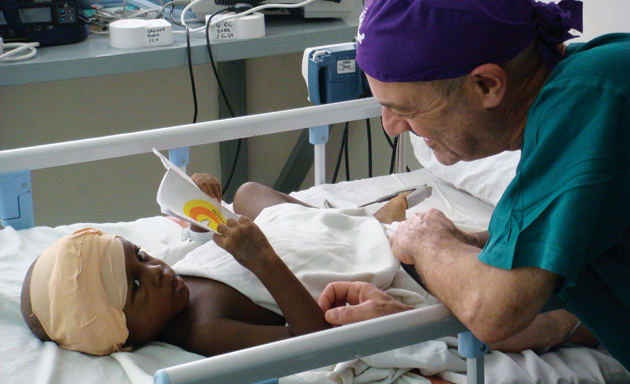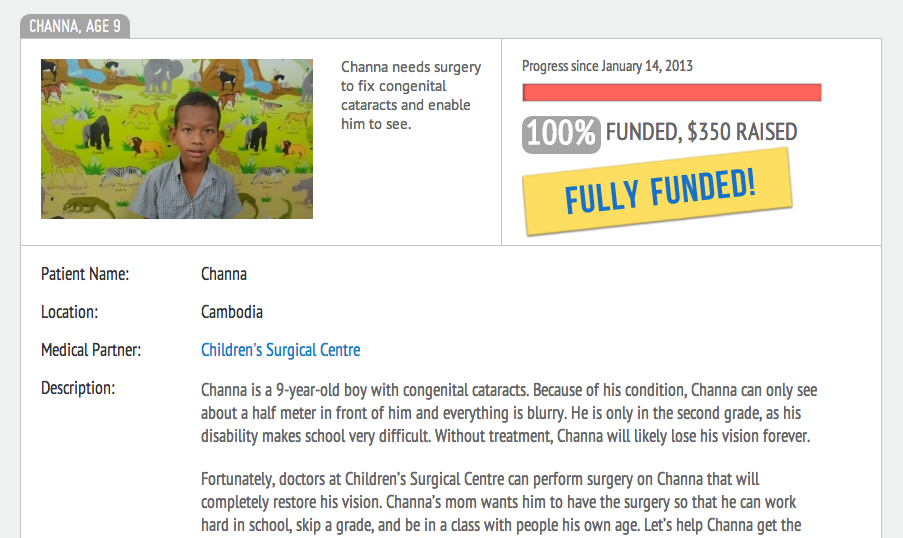Minor or routine surgery is a regularly available health option for many of us. But for the 1.3 billion people living on less that US$1.25 per day, there is no such thing as disposable income. For them and millions more, surgery of any magnitude is a luxury.

According to the World Health Organization:
In Uganda, there are less than 100 practicing surgeons serving a population of about 24 million -- that’s 1 surgeon for every 30,000 patients.
In Gambia and Malawi, there are no qualified anesthesiologists. This means that, when necessary, they have to “import” specialists to perform surgeries -- making the costs even more exorbitant.
Worldwide, an estimated 500,000 women die annually from pregnancy-related complications that require surgical intervention.
There’s an incorrect assumption that advanced surgeries are too sophisticated for doctors in the developing world. This means that even if surgery was an affordable option, there wouldn’t be anyone to perform many procedures. In many cases, there are no literally alternatives for millions of people affected by congenital conditions, infections, accidents and burns.
One serious health concern in developing countries is the result of muscle, bone, or joint infection. These infections are easily treated by draining the wounds as long as there is access to safe anesthesia, but when left untreated, can result in permanent disability or even death.
Another common condition that is especially prevalent is cleft lip and cleft palate. Every year, many children are born with gaps in their lips or roofs of their mouths, making it difficult to speak or eat. While both are easy to treat early in life through simple surgery, those who go without are often stigmatized, and even prevented from attending school or getting a job.
Like cleft palate, club foot is a congentital condition easily and effectively fixed by a casting treatment in the first weeks of a baby’s life. When left untreated, it can result in the difficulty or inability to walk, infections, and chronic pain. In the developing world, an estimated 80,00 babies are born every year with club foot, and the vast majority are poorly treated or not treated at all.
Kiva is working on financing solutions for health care and surgeries. Already, we’ve introduced a “Health” sector on the Lend page for loans to help borrowers buy medicine and other supplies to get them back on their feet. But we’d like to go further to make quality care affordable.
In the meantime, we’re thrilled to see other organizations emerging to tackle this problem. Most recently, Watsi -- a nonprofit organization that connects donors with patients throughout the world who can’t afford basic, but high-impact procedures -- became the first nonprofit to be selected by Y Combinator. Watsi’s structure is somewhat similar to Kiva, with users browsing profiles of patients and funding their treatments -- only what they give are donations, not loans.
For example, Channa is a 9 year-old from Cambodia who needed just $350 to fix congenital cataracts that limited his sight to half meter in front of him. With this relatively small amount of money, doctors will be able to completely restore his vision.

While there’s still considerable progress to be made, we believe that microfinance can make a huge difference in many parts of people’s lives. While Kiva plans to provide loans for health care, we believe that as economic opportunity expands, incomes will rise, more people will get the education they deserve, and basic health care and surgeries will become much more accessible.
Have questions about Kiva? Send them our way at blog@kiva.org.
Images courtesy of Barrick Beyond Borders and Watsi.
PREVIOUS ARTICLE
New Field Partner: Building businesses and supporting peace in Palestine and Jerusalem with JIMF →NEXT ARTICLE
Week in Review: Global Barometer of Hope and Happiness →














